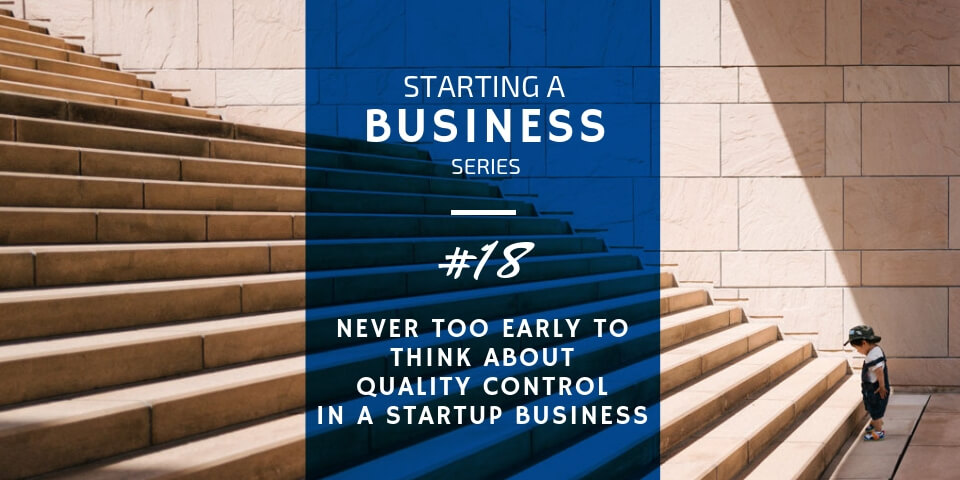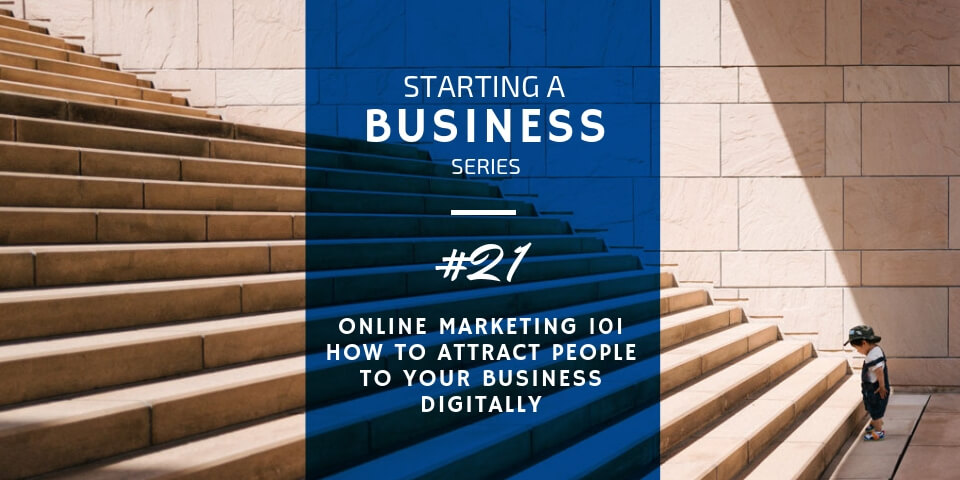
Quality Control in a Startup Business… Is it Too Early to Think About? – Article #18
October 22, 2018
Online Marketing 101: Attract People to Your Small Business Digitally – Article #21
November 2, 2018How to Get and Close Sales in a Startup Business – Article #19

Most likely, you began your business to meet a need in your marketplace. If you didn’t think people wanted or needed your product or service, then you wouldn’t have opened your business. However, how can you meet consumer needs if no one knows your business exists? You can’t just open a storefront and expect buyers to flock through your doors. No, you have to “sell” your products and services. They don’t talk, walk, or sell themselves, unfortunately. You and your team members must convince customers that they need what you’re offering. You’ve got to market and advertise to get customers into your sales funnel. Then, you’ve got to train your team to successfully close the sale. Ultimately, you must sell your company and its products or services to get and close sales in a startup business.
Podcast Time Index For “How to Increase Sales in Your Business”
00:30 – How to Increase Sales in Your Business
00:51 – A lesson from Coca-Cola
05:26 – The Two Facets of Sales
06:40 – Become an expert in your market
07:43 – Rank your targets
09:10 – Showcase your differences
12:24 – Craft your message to hit your targets
14:42 – Focus on existing customers
16:11 – Know your product life cycles
18:01 – Focus and streamline the conversion process
18:48 – Improving your Sales Team’s performance skills
26:25 – Conclusion
Products Don’t Sell Themselves
No matter how good your product or service is, people won’t purchase it if they don’t know it exists or if they don’t see a need for it. Take the Coca-Cola product as an example. The story behind Coca-Cola’s secret formula begins in Atlanta, Georgia with pharmacist John Pemberton, a wounded veteran of the Civil War. Seeking to find a cure for his morphine addiction, Pemberton brewed together kola nut and coco wine to make Pemberton’s French Wine Coca, a medicinal syrup. When Atlanta politicians passed prohibition legislation in 1886, Pemberton revised his formula to make a soda fountain drink without alcohol. Thus, Coca-Cola was born. However, Pemberton “never realized the potential of the beverage he created.”
In 1888, astute business and salesman Asa Candler purchased controlling interest of the Coca-Cola concoction from Mr. John Pemberton for $550. By 1891, Candler had purchased all stock shares of the product for a total of $2300, and his flair for sales and marketing sent sales sky-rocketing for this “refreshing,” “exhilarating,” and “invigorating” drink. Candler went on to incorporate the Coca-Cola company in 1892 and then to sell the company in 1919 for $25 million! Now, that’s not a bad investment on the original $2300. That’s pretty amazing.
What’s most interesting to me is that Candler knew he could use his advertising and sales talents to turn a “good” drinkable tonic into a successful business venture. John Pemberton created the Coca-Cola recipe. Yet, he didn’t know how to sell the product. If Asa Candler had never seen Coke’s® potential and developed a process to increase sales and revenue, Coca-Cola probably wouldn’t be worth some $179 billion dollars or so now. It definitely wouldn’t be the large company it is today.
Selling is a Two-Part Process
If you’re like me, you may not like sales. Selling just isn’t my gig. Personally, I’d rather educate my consumers than try to convince them to buy my products or use my services. I’ve even told clients not to hire me or pay me for services! I’m a terrible salesperson! But you know what? I believe that my services and knowledge are valuable to consumers. I believe that people need what I have to offer. Therefore, I have to “sell” my services. To grow my company, I have to drive my company’s sales which inevitably increases my top-line revenue. So how do I do that? If you’re not a born salesman, how do you convince others to buy your products or use your services?
I believe selling is a two-part process.
- First, your company must drive consumers into your sales funnel. In other words, your company has to market and advertise to the “right” people to promote awareness of your products or services. You have to show your targeted marketplace how your products or services meet their needs. If you can convince consumers that your products or services benefit their lives, then you transition them from an average consumer to a potential customer. Once you have done this, they enter your sales funnel.
- Once your company attracts consumer attention, your salespeople have a responsibility to turn an interested consumer into a paying customer. In other words, your salespeople must take customers from the wide top of the sales funnel through the narrow bottom of the sales funnel. They must connect with potential customers and showcase your company’s goods and services, making them relevant to individuals’ lives. Your salespeople must make the sale.
Part 1: Drive Customers into Your Sales Funnel
Let’s walk through the sales process, then. First, your company has to drive consumers into its sales funnel. You have to tell the “right” people about your incredible products or services and pique their interest. Here’s how:
#1 Target your market.
Identify the specific needs your company meets so that you can identify your target market. What pain points do you reach? What problem are you solving? If you don’t target a specific consumer, then you don’t have a customer. Therefore, the very first thing you have to do to bring customers into your sales funnel is to become an expert on your target market.
#2 Rank your targets.
The next thing you need to do is to rank your targets. Which of your proffered goods or services produces the most profit? Or, which client or buyer produces the most profit? Just because a product or service is glamorous or sexy doesn’t mean it’s profitable. Knowing which is most profitable for your company can help you identify your target market.
#3 Showcase the differences between your company and the competition.
Once you know who your target market is, you can laser-focus your marketing to reach the “right” consumers. Show them what sets you apart from competitors within your marketplace. Maybe it’s superior service or well-defined processes. Perhaps you have a better product. By understanding how your company’s products or services beat the competition, you become an expert in your field. As an expert. you can narrow your marketing focus to that target market and show them how your company meets their needs.
Related Reading: Mastering Competitive Advantage from my Building a Sellable Business Series.
#4 Craft a message that hits your target market.
When you understand your ideal customers and their pain points, then you can communicate with them on their level. You can speak their “language” in your advertisements. Use particular words, phrases, and images that reach the heart of your target marketplace. Because you know who they are, you can craft images and verbiage into messages that will tug on their heartstrings or pique their interest.
#5 Know your products’ life cycle.
Next, you’ll need to outline what customers can expect from your products or services once they purchase them. Do your products or services meet short-term or long-term needs? Can customers expect multiple uses from the product or reliable year-round service? Will consumers need to purchase again and again? The more information consumers have about your product, the more likely they are to purchase and/or continue to purchase the product. Furthermore, if you know customers need your product often, you can set reminders in your CRM system to contact them when they need your product again.
Related Content: To learn more about CRM or other management systems, read Business Scalability…Turbocharging Your Company’s Value from my Building a Sellable Business Series.
Part 2: Turn the Interested Consumer into a Paying Customer
Once you get the consumer into your company’s sales funnel, you must focus on the conversion process. How do you convert the consumer into a paying customer? Can you streamline that process? Essentially, you have to train your sales team or even yourself (if you are a solopreneur) to do the following:
#1 Meet goals and expectations.
If your company needs to average a certain number of sales or retain a certain number of new clients each month to be profitable, what do your salespeople need to do to make that happen? Do they need to make five phone calls each day or ten proposals per month? Should they bring in twenty referrals every quarter or receive 100 purchase orders each year? When you quantify your expectations, your sales team members will know what they must do and are more likely to do it.
#2 Sell to the need.
Since your company has identified its ideal customers, you know who needs your product. However, they don’t know they need your product. They don’t know how your products or services meet their needs. Therefore, your sales team members must throw out the proverbial lure to get the “fish” to swim up and take the bait. They have to know which bait to throw to entice consumers and make them customers.
#3 Sell on purpose.
Once you’ve attracted consumers with products and services that meet their needs, be purposeful in your sales presentation. Train your sales team members to be intentional in their cast, in their positions, in their bait, and everything they do to “lure in” consumers. Give them specific sales pitches to use and steps to follow in the sales process so they can reel in the “fish.”
#4 Take responsibility, not credit.
When you’ve “hooked” your customer, stay credible. In my opinion, good salespeople will give credit to the team when they experience success because they have a team pulling behind them. They won’t self-glorify or flaunt their own successes. However, if something goes wrong, I believe that good salespeople take responsibility for the fault and fix it even if someone else caused the problem. They earn clients’ respect by remaining honest and trustworthy.
#5 Get down to the basics.
Now, don’t forget the selling basics when you’re trying to close a deal. Maybe they’re hooked, but you still have to reel the customers into the final sale. Therefore, train your sales team to make eye contact, speak clearly, and listen well. Teach them to read body language and to work on their own body language. What they say and how they say it keeps them credible, just as taking responsibility does.
#6 Control your attitude.
Finally, to turn your interested consumers into paying customers, you and your sales team must control your attitudes. Don’t get “commission breath.” In other words, don’t beg for a sale. Show commitment to the consumer and enthusiasm for the products or services you’re selling. Remove negative and pessimistic attitudes because consumers will pick up on those. You’ll lose the sale before you can begin selling.
Be sure to join me in my next article where I talk about tax strategies you can utilize to save money in your startup business.
Do you need help creating effective sales processes within your startup business? Contact the business experts at Financially Simple for an assessment and to see if your needs are a good fit for our services!



